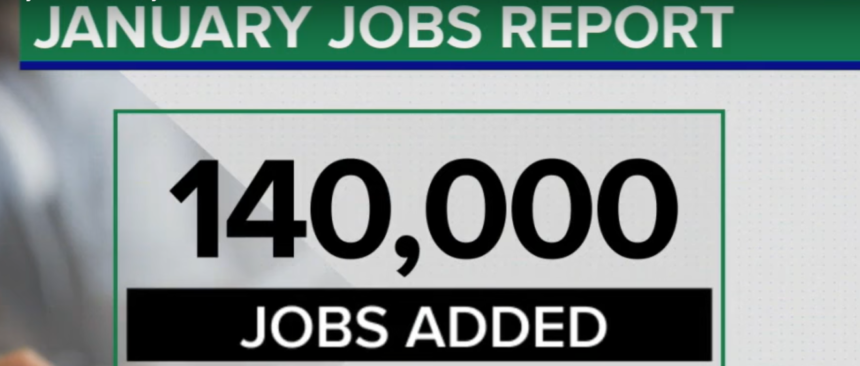The U.S. labor market showed signs of slowing down in January 2025, with job growth falling short of expectations while unemployment hit a historic low. According to the Bureau of Labor Statistics (BLS), nonfarm payrolls increased by 143,000 jobs, below the projected 169,000 and marking the smallest monthly gain since October 2024. Despite this, the unemployment rate dropped to 4.0%, the lowest since May 2024.
The January jobs report suggests that the rapid employment expansion seen in 2024 is beginning to moderate. The 143,000 new jobs added in January reflect a more measured pace of hiring, possibly influenced by adverse weather conditions, seasonal employment shifts, and slower economic momentum. In comparison, December 2024’s employment was revised upward to 301,000 jobs, highlighting a stronger-than-expected holiday season hiring trend. While the job market is not shrinking, the pace of hiring is no longer accelerating. Some industries, particularly those affected by seasonal factors and economic uncertainties, have begun scaling back employment opportunities.
Certain industries continued to thrive, adding a significant number of jobs. Health care led the way with 44,000 new jobs, reinforcing its position as a high-growth sector due to aging demographics and increased demand for medical services. Retail trade followed closely, adding 34,000 jobs, driven by holiday shopping spillover and consumer demand. The social assistance sector also saw growth, with 22,000 new jobs, reflecting increased investment in public services and community programs.
Not all industries experienced growth. The mining, quarrying, and oil and gas extraction sector lost 8,000 jobs, as lower energy prices and reduced drilling activity prompted layoffs and hiring freezes. This decline signals a possible slowdown in domestic energy production, which could impact inflation and energy policy decisions in the coming months.
One of the most noteworthy aspects of the January jobs report was the significant wage growth. Average hourly earnings rose by 0.5%, bringing the annual wage increase to 4.1%. The average hourly pay now stands at $35.87, reflecting continued pressure on employers to offer higher salaries due to labor shortages and inflation concerns. While higher wages benefit workers, they could contribute to inflationary pressures, prompting further scrutiny from the Federal Reserve as it evaluates potential interest rate adjustments.
The labor force participation rate remained unchanged at 62.6%, a sign that the U.S. labor market is still facing structural challenges. Many workers who left the workforce during the pandemic have not returned, and labor shortages persist in key industries. Some economists argue that an increase in workforce participation is necessary to sustain long-term economic growth.
Several external factors likely influenced the January slowdown in job growth: Severe winter storms and adverse weather conditions impacted employment in construction, transportation, and hospitality. Ongoing global supply chain disruptions affected hiring in manufacturing and logistics. Higher borrowing costs due to Federal Reserve policies may have discouraged some employers from expanding their workforce.
Despite slower growth, the job market remains resilient. Mass layoffs have not surged, and businesses continue to report steady demand for skilled labor. Even in sectors experiencing slowdowns, companies are opting for hiring freezes rather than job cuts, signaling confidence in long-term economic stability.
The financial markets reacted cautiously to the jobs report: The U.S. dollar strengthened, with the dollar index reaching 108.02 before settling at 107.88. Treasury yields spiked, influenced by revised job data from previous months, which were adjusted upward to 261,000 for November and 301,000 for December. Investors are now closely watching for Federal Reserve signals regarding potential monetary policy adjustments.
The Federal Reserve has been closely monitoring employment trends as it determines future interest rate policies. Given the slower job growth but strong wage increases, analysts believe the Fed may hold off on rate cuts for now. However, if inflation remains controlled, there could be room for moderate rate reductions later in the year.
While January’s employment data signals a slowdown, it does not indicate a recession. The U.S. job market remains historically strong, with low unemployment rates and continued wage growth. Key factors to watch in the coming months include: Whether wage increases sustain consumer spending. How industries adjust hiring strategies in response to economic conditions. The Federal Reserve’s policy decisions regarding interest rates.
The January 2025 jobs report presents a mixed picture—while job creation has slowed, the overall labor market remains strong. With unemployment at a historic low, wages rising, and layoffs minimal, the economy continues to show resilience. However, economic uncertainty and global challenges could shape employment trends in the coming months.
📌 Stay tuned for further analysis and updates on the U.S. job market!






